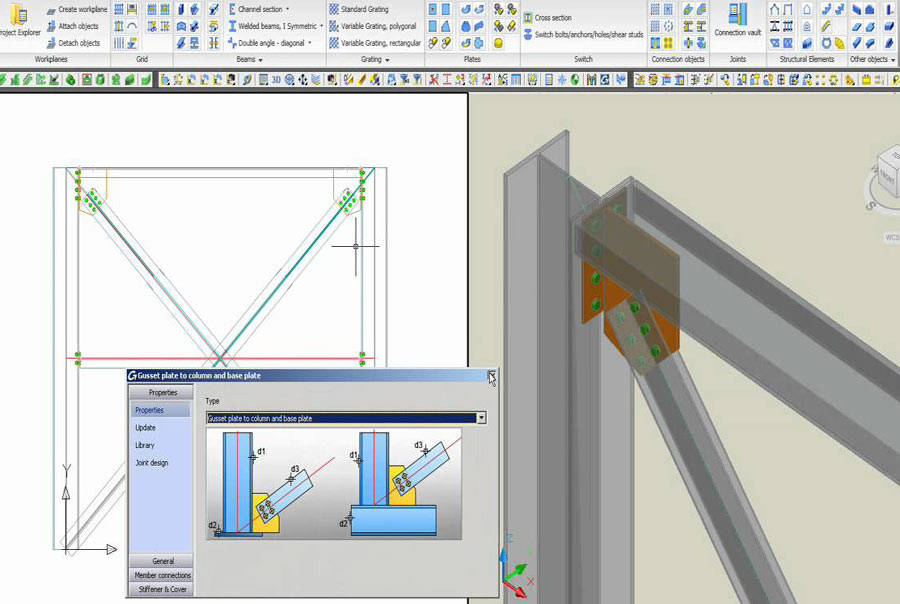
Steel Beam Connections

Steel beam connections are used to join different members of structural steel frame work; Steel Structure Collections attach various members to make them a unit.
Steel connections
Connections are like the structural elements which are used to connect various members of structural steel frame work and Steel Structure is a collection of different member like Beams, Columns which are joined with one another at member ends fasteners to show a single composite unit.
Types
Generally steel beam connections are used in structures and all beam connections are categorized into two groups like framed and seated connections. The framed steel beam is connected to the supportive steel element by fittings and the seated steel beam is placed on seat like to the case where beam is located on masonry walls.
This article mainly focuses on the different types of steel beam connections with their working process, steel beam connections are divided into following types:
Bolted Seated Steel Beam Connection
Bolted Framed steel connections
Welded framed steel beam connection
Welded seat steel beam connection
End plate steel beam connection
Special steel beam connections
Simple, rigid and semi-rigid connections
When a beam is joined with a support, a column or a girder with web connection angles, then the joint is names as ?framed?. Here every the connections must be plotted for the end reaction of the beam, its type, size and toughness of the fasteners and the capacity of bearing strength of core materials should be done. In these connections, the steel beams are connected in a way as supporting elements whether it is steel columns with the web connection angles and the minimum length of connection angle must be at least half of the beam clear web depth. The proportion is specified for right stiffness and solidity; there are different sizes of bolted framed connections besides their capability given by codes. This connection is required to enhance the rapidity of the design and minimum connection is enough to resist the applied load for making the design more economical.
In seated connection beams right sizes, capabilities and other data are filed in the AISC Manual, there are mainly two main types of bolted seated connections one of them is the soft bolted seat connections and hard bolted seat connection. When the reactions at the end of the beam are big then it is approved as hard or stiffened seat connections for their satisfactory capacity to oppose large forces. But the capability of soft or unstiffened seat connection is blocked for limited bending capacity of seat angle leg. The most helpful thing is that the beam in this connection can be invented economically and seat would give immediate support in the erection period.
This beam connection can be found in different sizes with their capabilities are available and supplied by codes. The weld of connection is bound to direct shave stress which caused by loads on the beam which beam affect weld pattern so the stresses are needed to be considered. The part of the welding is executed in a field where it seems difficult to get high quality weld for the movements of steel members caused by winds or other factors.
It is same as to bolt seat connection but used for bonding than bolts and the pressure on the beams affect the weld pattern curiously and create stress which need to be planned. The welded seat connections are of two types: unstiffened and stiffened, unstiffened is used for small loads and the stiffened is used to bear large loads. Use bolts to connect beam bottom border to the seat and the blots can be removed at their position after the end of their welded process. This connection is not requested from environmental point of view and worker as the connection can?t be erected easily.
This kind of connection is made through using the welding art and the end plate is joined to the beam by weld for its capability and size which are controlled by shear capacity of the beam web connected with the weld. The applied load on the connection at last of the member doesn?t have irregularities and the plate connections are of various types like flexible, semi-rigid and rigid. The fabrications and cuttings must be connected with the extreme care to stop errors but the end plate connections are not applicable to tall steel structures.
These connections are used for the case where the preparations of the structural element are placed in a way that standard connections can?t be used. The connections can transfer moments into the columns as per degree of fixity of the connections and the higher degree of fixity of the beam connection is the greater ability to transfer the moments into the columns.
Moment connections can transfer the forces in the beam sides to the column and this transfer moment must be provided for more and usually free of the shear connection needed to support the beam reaction. Simple, rigid and semi-rigid connections are designated simply to support beams and columns for shear only and leave the ends free to move under load. Besides carrying shear they provide enough rigidity to hold virtually unchanged angles between connected members.
Source: www.civilengineeringx.co


